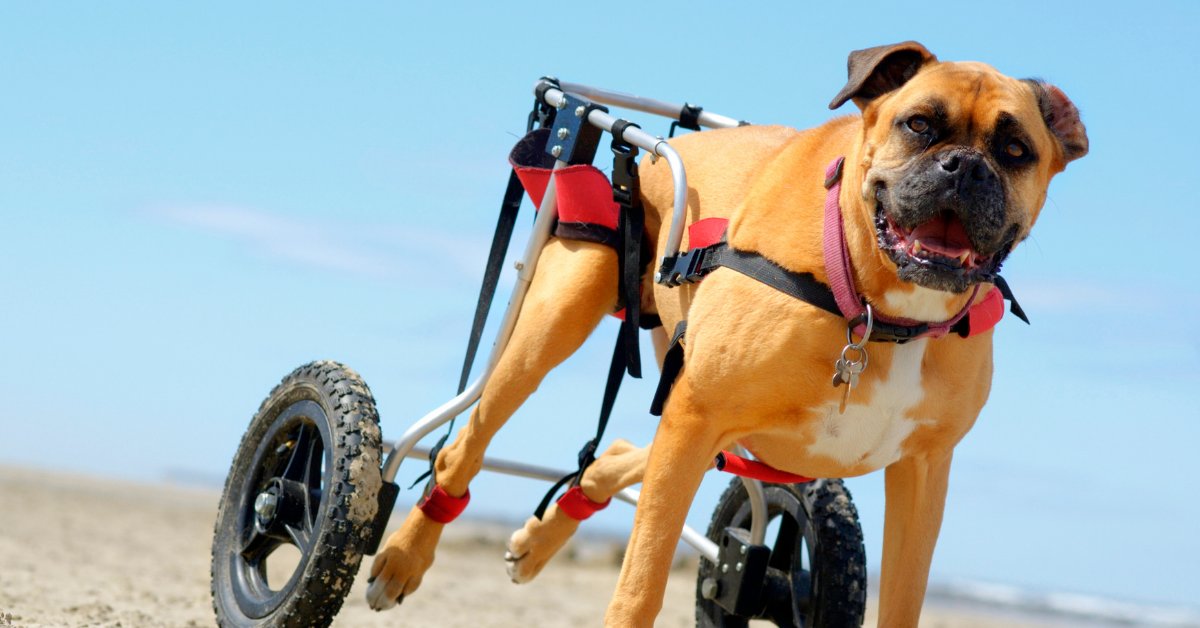
A dog's body is like a jigsaw puzzle. Where pieces meet and connect are the joints. As with jigsaw puzzles, these connection points are precisely sized for an exact fit. If you try to jam the wrong size piece into the space, you damage both pieces.
With hip and elbow dysplasia in dogs, the joint connections in those areas of the body are deformed. This makes it impossible for the normal perfectly-sized ball-and-socket joint action to occur. Over time, this leads to degenerative joint disease or osteoarthritis. Both are painful conditions that make walking difficult, and sometimes, even impossible.
Though similar in nature, hip dysplasia and elbow dysplasia in dogs are distinct conditions and manifest differently. Hip dysplasia affects the hindquarters of dogs, while elbow dysplasia affects the front.
Hip dysplasia is a deformity of the hip in which the "ball" part of the joint (the head of the thighbone) doesn't fit correctly into the socket (the pelvis). This is usually caused when one piece of the joint grows faster than the other. Hip dysplasia can be mild (close fit but not perfect) or severe (doesn't even come close to fitting).
Dog hip dysplasia is not uncommon. According to "The Demographics of Canine Hip Dysplasia in the United States and Canada," an article published in the Journal of Veterinary Medicine in 2017, 15.56% of dogs were diagnosed with the condition. (Researchers looked at the records of some 921,000 dogs.)
Canine hip dysplasia occurs during a puppy's growing years. As such, it's typically something that affects dog breeds that grow the most in their first year (ie large breeds). But some small dog breeds are also prone to the condition and, in fact, top the list of dog breeds that get hip dysplasia.
According to the Orthopedic Foundation for Animals, out of 942 pugs examined between 1974 and 2020, a whopping 71.8% displayed signs of hip dysplasia.
Right behind pugs is the bulldog, a breed that typically weighs in around the 50-pound mark. Of 1,172 bulldogs evaluated, 70.6% exhibited signs of hip dysplasia.
The first giant breed on the list of dog breeds that get hip dysplasia is the French Mastiff (or Dogue de Bordeaux), which comes in at number 4. Of 767 French Mastiffs that were evaluated, 56.7% were dysplastic.
Though hip dysplasia begins during puppyhood, the visible symptoms may not be apparent for years.
An improper diet during a puppy's growing years can also result in hip dysplasia but this is not as common, except among large breed dogs. Some dog food manufacturers offer large-breed puppy foods specifically designed to slow down puppies' growth spurts so their joints can develop normally.
Dog hip dysplasia symptoms can appear anywhere between the ages of a few months and several years. The severity of these symptoms can vary.
Here are a few of the warning signs of hip dysplasia in dogs owners should be aware of:
There are several treatment options for dogs with hip dysplasia. In the most severe cases, your veterinarian will suggest surgery. In milder cases, lifestyle changes may be all that's needed. For instance, an overweight dog with hip dysplasia can be helped by losing weight.
In other cases, exercise restrictions, physical therapy, and chiropractic care can help.
Your veterinarian may also suggest adding an anti-inflammatory medication or joint supplement (like Veterinary Formula Clinical Care's Ultimate Joint Health).
Like canine hip dysplasia, elbow dysplasia in dogs is a deformity of the joint. In this case, the bones that make up the elbow joint don't fit correctly. The results – lameness, stiffness, joint disease, and osteoarthritis – are the same.
(The term "elbow dysplasia" encompasses several distinct conditions. They are: fragmented coronoid process (FCP), osteochondrosis (OCD), joint incongruity, cartilage anomaly, and ununited anconeal process (UAP).)
Incidences of elbow dysplasia in dogs are graded on a scale of 1 to 3. Level 1 elbow dysplasia is considered mild. Level 2 is moderate and level 3 is severe.
Elbow dysplasia in dogs is not as common as hip dysplasia, but is a problem for large to giant breed dogs.
Topping the list of breeds prone to elbow dysplasia are the Chow Chow and Rottweiler.
According to the Orthopedic Foundation for Animals, of 1,393 Chow Chows examined between 1974 and 2020, 49.8% were dysplastic, with most (26.9%) graded at a level 1 and 17.1% at a level 2.
Of the 22,339 Rottweilers, 38.8% showed signs of elbow dysplasia, with the majority (29.5%) graded at level 1.
Other large breed dogs at risk for canine elbow dysplasia include the American Bully, Bernese Mountain Dog, Shar-Pei, Newfoundland, German Shepherd, Pit Bull, and Bullmastiff, among others.
A handful of small dogs are also prone to elbow dysplasia, including the Pug, Sussex Spaniel, and Pembroke Welsh Corgi.
As with hip dysplasia, puppies are usually born with elbow dysplasia. Early trauma or a poor diet can also lead to some version of the condition.
Canine elbow dysplasia symptoms can manifest at a young age (usually 6 to 10 months), particularly in moderate to severe cases. In milder cases, signs of the disease may not show up for years but by then most dogs will be suffering from advanced arthritis.
Here are some signs of elbow dysplasia in dogs to be aware of. Keep in mind, in most dogs with elbow dysplasia both elbows are affected, though possibly more on one side than the other.
Determining which canine elbow dysplasia treatment is right for your dog depends on which type of elbow dysplasia is present. Surgery can help, though primarily only when the disease is caught in the early stages. Once advanced arthritis has set in, there is little that surgery can do.
Lifestyle changes that may help are the same as those for dogs with hip dysplasia: weight loss, restricted exercise, physical therapy, prescription anti-inflammatory medicines, and dietary supplements.
Product Picks